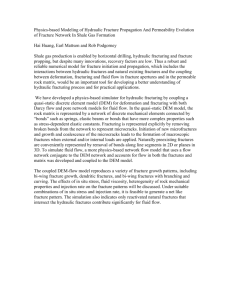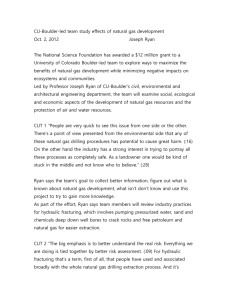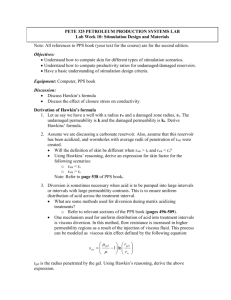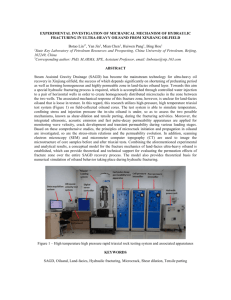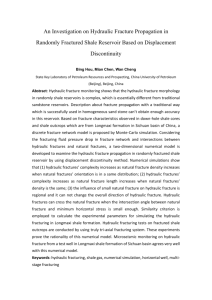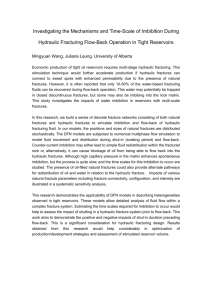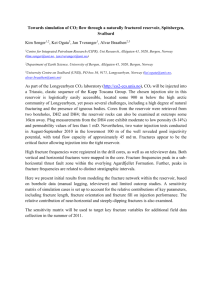Understanding Hydraulic Fracturing
advertisement
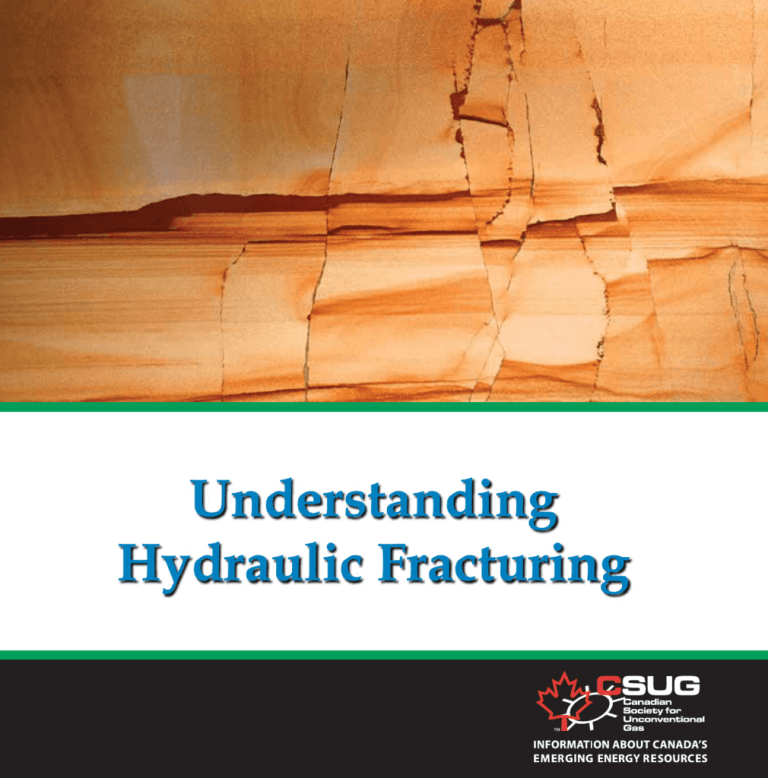
Understanding Hydraulic Fracturing Natural gas is a safe, abundant and economical source of energy for the planet. North America has relied on natural gas for heating homes and buildings, as a fuel source for cooking and as a reliable supply of energy for electrical generation for many years. In the past, the oil and gas industry has explored and developed what are referred to as conventional natural gas deposits throughout the country. More recently as these supplies have declined, the industry has concentrated their efforts in developing unconventional gas resources. The natural gas produced from these new sources is no different than conventional gas. Unconventional resources tend to be more expensive to develop and require special technologies to enable the gas to be produced. One of the primary technologies that is employed to enable economical gas production from unconventional reservoirs is hydraulic fracturing. Hydraulic fracture stimulations for shale gas or tight gas reservoirs often require large amounts of equipment on site during the treatment operations Hydraulic Fracturing is the process of transmitting pressure by fluid or gas to create cracks or to open existing cracks in hydrocarbon bearing rocks underground. • Rock properties of the potential reservoir The purpose of hydraulic fracturing an oil or gas reservoir is to enable the oil or gas to flow more easily from the formation to the wellbore, a process known as stimulation. Almost all of the onshore North American reservoirs remaining today require some sort of stimulation treatment to be able to bring production rates to economic levels. • Well construction - type of wellbore cement and casing The type of hydraulic fracturing used is dependent on a number of variables: As companies look to fracture stimulate the well that has been drilled these variables will influence the type of hydraulic fracture process that will be used. • Type of well that has been drilled (vertical or horizontal) • Depth, thickness, temperature and pressure of the reservoir • Number of fractures to be completed in the wellbore • Choice of fracturing fluids and materials • Cost of fracturing and materials What is Hydraulic Fracturing? What is Hydraulic Fracturing? History of Hydraulic Fracturing Oil and gas discoveries were initially found as seeps where hydrocarbons were naturally present at surface. Early exploration efforts were focused on finding reservoirs that easily and energetically flowed oil or gas to surface. During the last 127 years oil and gas have been extracted from reservoirs in many regions across Canada. Initially, these reservoirs were easy to produce and in many cases did not require stimulation. These types of highly permeable and easy to produce sources of oil and gas are called conventional reservoirs. Over time many of these sources of oil and natural gas have been found and are being depleted. In most cases, the new oil and gas resources currently being developed are in more difficult to produce reservoirs. These sources of hydrocarbons are referred to as “unconventional resources”, and usually require different or unique technologies to recover the resource. As companies moved towards more difficult to produce hydrocarbon reservoirs technologies were developed to aid in improving the flow characteristics of the productive zones. The most dramatic technological advancement occurred post World War II with the development of hydraulic fracturing techniques. For the past 60+ years, the industry has been developing newer enhanced and cost effective means of fracture stimulating reservoirs. These improvements have included types of fracturing fluids, surface and downhole equipment, computer applications and modeling of fracture treatments and the science of fracture creation in relation to tectonic stresses. Since the commercial application of hydraulic fracturing in the late 1940’s, more than a million wellbores have been drilled and stimulated using hydraulic fracturing. What has changed is the setting in which these techniques are being applied (see Understanding Shale Gas in Canada, CSUG 2010). Complex wellbores such as vertical boreholes with multiple horizons on horizontal wells that intersect a larger interval of hydrocarbon bearing rock are now the primary types of wells being drilled. Hydraulic fracturing technologies have been and continue to be adapted to more challenging reservoir settings to enable economic production of oil and gas. First commercial hydraulic fracturing job was at Velma, Oklahoma in 1949 (Courtesy of Halliburton, 2010) History of Hydraulic Fracturing The techniques that are being employed today in shale gas exploration are not significantly different to those that were used 60 years ago. A reservoir containing hydrocarbons is subjected to pressures through fluids at depth, causing the rock to crack (one or more fractures) allowing hydrocarbons to flow to the wellbore more easily. What Regulations Govern Hydraulic Fracturing? Canadian regulators and the natural gas industry are focused on the protection of surface and groundwater and the mitigation of risk. All Canadian jurisdictions regulate the interface between water and the natural gas industry, and the application of evolving hydraulic fracturing techniques for unconventional gas development is no exception. These regulations are set and administered by a number of federal and provincial Ministries, including environment, natural resources, sustainable development, energy, transport, industry and others. In addition, major producing jurisdictions have oil and gas regulatory entities – either provincial boards or the federal National Energy Board. Two key programs by which the Government of Canada manages substances are the Chemicals Management Plan and the New Substances Program. Substances for use in the oil and gas industry (e.g., lubricants, drilling fluids, corrosion inhibitors, surfactants, fracturing fluids, desulfurization agents, and bacteria control agents) are subject to these two programs. In addition to the regulations governing the chemicals some provinces require the details of the Hydraulic Fracturing treatment to be submitted to the oil and gas regulator. In Alberta the Energy Resources Conservation Board (ERCB) through EUB Directive 059: Well Drilling and Completion Data Filing Requirements requires that for all fracturing operations the operator must submit the minimum data: type, quantity, and size of propping agents, type and volume of carrier (fluids), additives, type and quantity of plugging agents, feed rates, and pressures. Surf ace Municipal water well Private well Shallow groundwater aquifer Deep groundwater aquifer Surface gas-well lease Protective steel casing: Steel casing and cement provide well control and isolate groundwater zones 1,00 0m LLim imeesto stonne e HYDRAULIC FRACTURING 1,50 0m 2,00 Induced shale fractures 0m San dsto Gas ne -rich Hori zon 2,30 0m shale tal b ore Note: Buildings and well depth not to scale Source: Canadian Natural Gas Once the fracture treatment is completed, fracture fluids are flowed back to the wellbore where they are recovered at surface and stored for re-use or future disposal. Treatment and/or disposal of fracture fluids and produced formation waters is undertaken in accordance with regulations in each jurisdiction. If the fluids cannot be treated and reused for fracturing operations, they must be disposed in a government approved disposal well or facility. The volumes and rates of fluids disposed are monitored and reported to the regulatory body. In addition to fluid treatment regulations, all other wellbore regulations apply for unconventional wells such as protective berms around the surface tanks, etc. For more information regarding specific oil and gas regulations, readers are referred to the specific regulatory agencies for each provincial jurisdiction. What Regulations Govern Hydraulic Fracturing? Schematic of a horizontal well relative to ground water Why do we Hydraulically Fracture Oil & Gas Reservoirs? Natural gas and other hydrocarbons are commonly found in the thick package of rocks that comprise sedimentary basins. During the past 50 years, our understanding of the creation and trapping of natural gas in sedimentary rocks has improved and explorationists recognize that natural gas can be found in many types of rocks in the subsurface. Most sedimentary rocks have the ability to store natural gas in the small pores or spaces within the rock, but their ability to allow the flow of hydrocarbons out of the reservoir rocks is controlled by the connectivity or pathways that link the pore spaces. The differentiation between what we have called in the past conventional reservoirs, and the new unconventional reservoirs is primarily a function of the reservoir’s ability to flow hydrocarbons. Conventional oil and gas reservoirs usually have interconnected pathways within the rock matrix that allow the hydrocarbons to flow to the wellbore, sometimes without stimulation. In unconventional reservoirs, often the grain size of the rock matrix is much smaller and the pores (the spaces between the mineral grains) are poorly connected (Figure A). In these types of reservoirs, while there are significant quantities of hydrocarbons trapped in the rock matrix, there are limited connected pathways that allow the hydrocarbons to flow. The process of hydraulic fracturing is designed to produce fractures or connect to existing fractures within the reservoir thus creating a pathway by which the hydrocarbons can flow to the wellbore (Figure B). Conventional Tight Reservoirs Hybrid Reservoirs Figure B Organic-rich Black Shale Shale or Coalbed Methane Reservoirs Silt-Laminated Shale or Hybrid Highly Fractured Shale Modified from Hall, 2008 Migration of hydrocarbons to the induced fracture Why do we Hydraulically Fracture Oil & Gas Reservoirs? Figure A Well Construction A key element of successful hydraulic fracturing is proper well construction. During the drilling and completion process proper techniques must be used to ensure: • groundwater is isolated from the wellbore and protected from completion and production operations, and; • damage to reservoir rocks is minimalized so that flow to the wellbore is not inhibited. The critical aspects of proper well construction are the selection and application of casing and cement. To provide the protection necessary, usually three steps are taken to isolate the wellbore from the surrounding rock intervals that have been penetrated during the drilling process. In stage I, where necessary, a surface hole is drilled to the base of the unconsolidated material lying near the surface. The casing (commonly referred to as conductor pipe) is inserted into the hole and cemented in place. At this stage, a barrier is created to prevent fluids migrating into the shallow unconsolidated gravels and sands at surface as well as preventing these materials from falling into the wellbore. The wellbore is then drilled to a depth defined by the regulatory agencies as being below the base of groundwater protection and sufficient to provide the necessary mechanical strength for future drilling and reservoir stimulation operations. In stage II, a second set of steel casing (surface casing) is cemented into the wellbore (cement over the entire vertical interval drilled) to isolate any shallow aquifers from the wellbore. The cement is allowed to set prior to continuation of drilling and in some places, a “cement bond” geophysical log is run to determine the integrity of the cement that surrounds the surface casing. Once the well is drilled to target depth and having intersected the hydrocarbon zone(s) a production casing string is lowered into the wellbore. This second (or third) set of steel casing is usually cemented into place providing isolation of the hydrocarbon zone. In some cases, where the borehole is to be completed “open hole” , the casing is cemented in place above the target Continuation of Wellbore To Target Zones(s) Fracture Propagation Schematic illustrating protection of shallow groundwater horizons CSUG, 2011 Well Construction zone leaving the zone to be stimulated free of In stage III, the wellbore is drilled to its total depth. In some cases, depending on the total any cement that might create formation damage. depth of the well or the orientation (horizontal or vertical) an Domestic intermediate set of casing may be Wellhead Water Well inserted into the wellbore and Conductor Pipe Gravel cemented in place. The decision to Cement Surface Casing install additional casing is based on expected reservoir conditions as well Production Casing as completion and stimulation Base of Groundwater Protection techniques that are to be used. Process of Hydraulic Fracturing After the well is drilled and cased to the target depth, holes or perforations are made in the production casing to provide entry points by which the fracturing fluid and proppant can enter into the targeted hydrocarbon zone(s). The number and orientation of the perforations is pre-determined and designed to intersect the natural fracture system that may be present in the reservoir (later, these same perforations allow gas to enter the well). Hydraulic fracturing equipment is then brought to the surface location and connected to the wellbore for the fracture treatment. Hydraulic fracturing is essentially a 4-step process: Step 1: Pressure the reservoir rock using a fluid to create a fracture Step 2: Grow the fracture by continuing to pump fluids into the fracture(s) Step 3: Pump proppant materials into the fracture in the form of a slurry, as part of the fracture fluid Step 4: Stop pumping and flowback to the well to recover the fracture fluids while leaving the proppant in place in the reservoir from Complete Production Services Typical unconventional resource fracture stimulation illustrating the amount of equipment required Schematic of perforating gun creating holes within production casing across target interval From Blue Ridge Group Inc. Preparation of perforating tool Halliburton, 2010 Following the initial fracture fluid load, a fluid/proppant mixture is pumped into the opened fractures (Step 3), to keep them open by depositing the proppant in the fracture network. The fracture fluids are then flowed back to surface when the treatment is completed (Step 4). Process of Hydraulic Fracturing At the surface fluids are mixed with a small amount of chemicals and fed to the fluid pumpers where it is pumped down the wellbore. The fluid is pushed by pressure (Step 1) into the formation causing it to crack. The fracturing pressure must be greater than the stress that geological forces apply to the reservoir rock (known as tectonic stress) but within the pressure rating of the well and fracturing equipment. Once a fracture has been initiated, an increasing amount of power is required to extend the growth of the fracture network (Step 2). This extra power is supplied by the rate at which the fluid is pumped and the fracture fluids’ ability to keep the cracks open as the fracture grows in length. Science of Hydraulic Fracturing Fractures in oil and gas bearing rocks will extend along “the path of least resistance”. At any point in the zone of interest, the rock will have three stresses acting upon it: a vertical stress primarily due to the weight of the rock that lies from the surface to the depth of the target zone, and two horizontal stresses that may be thought of as front to back and side to side. The fracture is created by using fluid pressure to “push back” against the least of these 3 stresses thus opening a fracture. At the depths of typical shale gas formations, the lowest stress will be one of the horizontal stresses as the weight of the rock above exceeds any of the forces squeezing from the sides. Pushing against the lowest horizontal stress results in a vertical fracture, much like pushing horizontally against a jammed door creates a vertical opening. Once a fracture is initiated it will extend, provided that additional fluid is pumped to maintain the pressure within the fracture. How Far will the Fracture Go? In the vertical direction, the fractures will extend until they reach a more ductile rock material. Ductile materials such as softer shales are more difficult to fracture than brittle shale rocks. These ductile layers provide the containment and cause the remaining fracture to travel horizontally within the more brittle layer(s). The fracture will extend laterally as long as the fluid pressure within the fracture exceeds the lowest stress pressure. Several factors constrain the unlimited growth of a fracture in a lateral plane: • The fracture fluid tends to disperse into the rock formation • The fracture fluid may encounter pre-existing natural fractures and follow them • As the fracture extends, sometimes as much as several hundred metres, the fracture pressure of the fluid required increases beyond the capability of the pumping equipment Computer models are often used to evaluate options prior to treatment. During the treatment staff and software are evaluating the operating parameters and make adjustments to ensure safety and efficiency of the work performed. After the treatment, the actual recorded parameters may be input into a software model to better understand the results of the stimulation. Once the treatment is completed the fracturing equipment is moved off location and the lease is prepared for flow testing and production. The well head is tied into a fluid recovery tank and commonly the gas is diverted to a flare stack for a short period of time until the fluid recovery is diminished. The water used for oil and gas production is often considered to be consumed water, since it comes into contact with hydrocarbons and salts in the reservoir, and cannot be returned to the environment without additional treatment. Where possible, companies will treat the fluids used for fracturing and recycle them. If the fluid is not recycled, it is recovered and disposed of as required by provincial regulations. Fracture modified from Halliburton, 2010 Schematic of reservoir stimulation, illustrating primary stresses 15 Science of Hydraulic Fracturing Even if large fractures can be created, the work performed must be economically balanced to the resulting production return from the treatment. The volume of fracture fluid and proppant used for each hydraulic fracture varies dependent upon the anticipated production rates following the treatment and the tectonic stresses of the reservoir rocks that are to be fractured. Hydraulic Fracturing Equipment The process of hydraulic fracturing is very equipment intensive, usually for a short period of time. Single fracture treatments, dependent on the size, can usually be completed within a single day. In more remote locations such as the Horn River Basin in northern British Columbia, commonly multiple wells are drilled from a single pad (a single surface location) and the hydraulic fracturing treatments are then undertaken. In vertical wells, where a thick reservoir is present and in long horizontal wells operators may undertake stimulation treatments at multiple Data Monitoring Van Frac Pumps Wellhead Frac Blender Chemical Storage Trucks Sand Storage Units Frac Tanks - Stimulation Fluid Storage from Chesapeake Energy locations in a single well. When this multi-stage hydraulic fracturing approach is used there may be as many as 150 fracture treatments performed from a single surface well pad and the entire process may take several months to complete. The surface fracturing equipment consists of multiple pumping units (the greater the size of the treatment(s), the more pumping capacity required), blending units, control units and adequate supplies of fracture fluid and proppant material. Commonly these supplies are stored in tanks or containers at the wellsite. Once the fracture treatments are completed, the fracture fluids are flowed back to the well where they are treated for reuse or disposed of in government approved disposal facilities. The equipment is then de-mobilized and the wellsite is relatively free of equipment save any further fluid storage requirements and production equipment. Hydraulic Fracturing Equipment Frac Pumping Unit Data Collection Van Proppant Transfer Truck Courtesy of Calfrac Well Services Types of Hydraulic Fracture Fluids The choice of hydraulic fracture fluid is dependent upon the reservoir’s properties. Although water-based fluids are more common, some reservoir rock types contain water sensitive clays and other fluid types are used. In all cases, the fracture fluid, whether it is a liquid or gas, is injected into the reservoir under pressure to create and open a fracture system. Other types of fracture fluids commonly used include gases such as carbon dioxide, nitrogen, propane and oil based fluids. Water is the most common base fluid used in hydraulic fracturing due primarily to the low cost and abundant supply. In water based fracture stimulations, primary water compatibility tests are conducted prior to the fracturing process. The volume of fracture fluid is highly variable depending on size and number of treatment operations. In a deep horizontal well a multi-stage treatment might use between 3,500 m3 and 15,000 m3 of water whereas in shallow operations where a single zone is being stimulated, 20 m3 to 100 m3 of water is more common. For clarity, the volume of water used for a hydraulic fracturing operation can range from zero to tens of thousands of cubic metres, depending on the geological and reservoir characteristics. Fracture treatments typically take place only once per zone and usually are completed at the beginning of a well‘s productive life. Depending on the type of rock or reservoir wells will produce for 7 to 30 years without requiring any further fracturing and related water use. Commonly the water used in fracturing activity is withdrawn from local fresh water sources. Where possible many operations are using other water sources like non-potable brackish water and/or are recycling recovered fluids. Including these alternate water sources as the base fluid reduces the demand for water and impacts on surface water and aquifers. Depending on the location or size of the treatment the water is trucked or piped to the well site where it is stored either in tanks or large ponds. Chemicals are often added to the water to make a highly viscous, low friction fluid that will readily carry the proppant material and withstand the rigors of traveling to the zone of interest and return to surface. Chemical use in the process must comply with the Provincial and Federal regulations. The number of chemicals and concentrations added to the fluid proppant mixture is highly variable and dependent upon the specific properties of the reservoir. Individual companies will have their own proprietary combination of these chemicals but the combined concentrations are usually less than 1% of total volume of the fluid proppant mixture. Volumetric Composition of a Fracture Fluid Friction Reducer 0.088% Water and Sand 99.51% Other 0.49% Acid 0.123% Biocide 0.001% Corrosion Inhibitor 0.002% Iron Control 0.004% Crosslinker 0.007% Breaker 0.01% pH Adjusting Agent 0.011% Scale Inhibitor 0.043% Gelling Agent 0.056% KCl 0.06% Surfactant 0.085% Modified from: ALL Consulting, based on data from a fracture operation in the Fayetteville Shale, 2008 Types of Hydraulic Fracture Fluids & the Chemicals Used Chemicals Used in Fracture Fluids Monitoring Fracture Treatments During the hydraulic fracturing process, it is imperative that the fracture treatment be monitored and controlled. Pumping rates and pressures of the fracture fluids and proppant are controlled by specialists on site. Wellbore pressures are monitored to determine how the fracture treatment is proceeding. micro seismic event which can be recorded by offsetting monitoring wells or seismic arrays using extremely sensitive detectors. This new process for monitoring fracture treatments is commonly referred to as micro-seismic monitoring. A variety of additional techniques or tests may also be used in conjunction with the hydraulic fracturing operation to help determine the degree of success of the treatment. These include sophisticated testing of isolated intervals in the well during flowback, and observations of extremely small seismic events when fractures are created. During the fracturing process, the pressure created by the pumping of fracture fluids creates stress on individual contact points within the reservoir rock. As these points fracture, the movement at the point creates a from Geospace Technologies In the adjacent picture, micro-seismic events are plotted relative to the horizontal wells from which the fracture stimulations were undertaken. Individual colored dots represent the individual micro-seismic event for each stage of the total fracture stimulation. Coloured dots represent the individual microseismic events created during the hydraulic fracturing process Horizontal leg of well Modified from ESG, 2010 Monitoring Fracture Treatments Multi-well pad surface location Using computer modeling software, the location of these micro-seismic events can be plotted in a three dimensional space allowing the configuration of the fracture treatment to be observed. As the micro-seismic events are measured in real time, adjustments can be made to the fracture treatments to ensure that the fractures are being contained within the reservoir zone. Glossary & Terminology Damage (Formation Damage): Changes to a reservoir rock Permeability: The ability of the rock to pass fluids or gas that have a negative impact on the ability of the reservoir to through it. The higher the permeability number, the greater produce gas or liquids; commonly considered to be a reduction the amount of fluid or gas that can flow through the rock over a in permeability caused by drilling operations. fixed time period. Permeability is measured in a unit called Flowback: The flow of fracture fluid back to the wellbore after the treatment is completed. Hydraulic Fracturing (aka ‘Fracing’): A method of improving the permeability of a reservoir by pumping fluids such as water, carbon dioxide, nitrogen or propane into the reservoir at sufficient pressure to crack or fracture the rock. The opening of Darcies. Conventional reservoirs may have permeabilities in the 10’s to 100’s of millidarcies or occasionally Darcy range. Unconventional or tight reservoirs usually have permeabilities in the micro to nano darcy range (one millionth of a millidarcy). Porosity: The free space within the fine grained rock that can store hydrocarbons . natural fractures or the creation of artificial fractures to create Propping Agents/Proppants: Non-compressible material, pathways by which the natural gas can flow to the wellbore. usually sand or ceramic beads, that is added to the fracture Microseismic: The methods by which fracturing of the reservoir can be observed by geophysical techniques to determine where the fractures occurred within the reservoir. Multi-Stage Fracturing: The process of undertaking multiple fracture stimulations in the reservoir section where parts of the reservoir are isolated and fractured separately. fluid and pumped into the open fractures to prop them open once the fracturing pressures are removed. Reservoir: The rock that contains potentially economic amounts of hydrocarbons. Common chemical additives used to build fracturing fluids may contain a number of the following additives: TYPE Gellants or Gelling Agents: increase viscosity, proppant suspension and provide lubrication. Guar Gum Polyacrylamide Crosslinkers: used in small quantities to join polymers in a three dimensional shape. Boron, Zirconium, Titanium or Iron Clay Control: used in water sensitive formations to prevent clays from swelling. Potassium Chloride Breakers: breaks the polymer chain created by the gelling agent. Oxidizers Enzymes Surfactants: lower the surface tension on the fracturing fluid Flow back additives Biocides: prevent the introduction of sulphate reducing bacteria into wells. Natural and Manufactured Biocides Energizers: gases used to energize (or foam) fluids for fracturing treatment. Carbon Dioxide (CO2) Nitrogen (N2) Canadian Society for Unconventional Gas (CSUG) Suite 420, 237 - 8th Avenue SE Calgary, AB T2G 5C3 Phone: 403-233-9298; Fax: 403-233-9267 Email: info@csug.ca; Web: www.csug.ca May not be reproduced without written permission from the Canadian Society for Unconventional Gas
